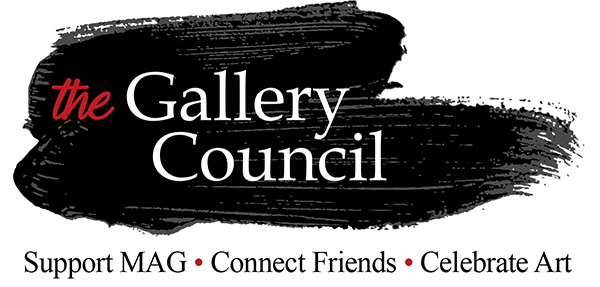Cow Wallpaper
Warhol was a pioneer of installation art. The same year that he created Silver Clouds, he produced Cow Wallpaper, which has since covered the walls of Warhol exhibitions across the world. Arrayed in vertical strands, Warhol’s pink cows recall strips of contemporary photo booth portraits, which typically came stacked in groups of four. The reference, now historical, also relates to motion-picture film and the film-strip format. Photography underpins all of Warhol’s art.
At MAG, the north wall of the Vanden Brul Pavilion will showcase Warhol’s signature fluorescent pink cows on a bright yellow ground. This contribution to art history’s pastoral tradition provides an appropriately ironic context for the complete portfolio of the artist’s eerie Electric Chair prints of 1971, which will be hung on the wallpaper. Why juxtapose images in assorted colors of the Sing Sing Correctional Facility’s electric chair, which was the last to execute a person in New York State, with the garish Cow Wallpaper? Combining the banal with a most serious subject matter, in this case, an image of death and capital punishment bespeaks the essence of Warhol’s intellectual project. Beneath the colorful, appealing, fun surfaces of the artist’s whimsical imagery lies a darker and oftentimes more critical story of American culture.
Silver Clouds
Warhol first exhibited his helium and air-filled, pillow-shaped balloons called Silver Clouds at the Leo Castelli Gallery, New York City, in 1966. He had recently announced his retirement from painting in order to focus on filmmaking—he never did stop painting—and worked with Billy Klüver, an electrical engineer at Bell Labs, to create the floating metalized polyester-film forms. Warhol is often quoted as saying, “I thought that the way to finish off painting for me would be to have a painting that floats, so I invented the floating silver rectangles that you fill up with helium and let out of your windows.” In a token effort to declare the end of painting, Warhol created a pioneering interactive art installation that has engaged and delighted participants of all ages ever since.
Warhol TV
For Warhol, television was a way to make anyone famous, and he often used informal real-time footage, a prescient version of today’s “reality TV,” to feature both trivial and glamorous subjects. This exhibition in MAG’s Media Arts Watch gallery showcases three of Warhol’s TV series as well as some of his live TV appearances, video clips, and advertisements. More recent material drawn from YouTube explores how his tabloid television anticipated contemporary modes of mass media production. True to the original medium, and in honor of Warhol’s visionary obsession with popular culture, Warhol TV is presented on an outdated CRT television inside a basement hangout space, complete with furniture, games, and a Season of Warhol T.V. Guide.
Warhol experimented with the television medium starting in 1955, when he acquired his first RCA TV set, until the last decade of his life, when he had a celebrity program on MTV called Andy Warhol’s Fifteen Minutes. Between 1979 and 1987, Warhol aired 42 television broadcasts for private cable channels including MTV and Madison Square Garden Network. Like the Factory and the hundreds of films that he created over the course of his career, Warhol’s TV series was full of appearances by well- and lesser-known personalities from the fashion, film, music, art, and queer scenes. Interviews and conversations alternated with visits to in-vogue nightclubs like Studio 54 and The Tunnel, fashion shows, and music performances.
This installation includes a selection of contemporary YouTube videos and advertisements for local community events that owe a debt to Warhol’s pop media aesthetic. Warhol approached TV in as concentrated and dedicated a manner as he approached his work in almost any medium. Artistic experimentation took the form of niche broadcasting, which connected art with popular culture through the expanding network of cable television channels. His tabloid television fueled media voyeurism and celebrity culture, anticipating YouTube vloggers, Instagram fame, and today’s fastest-growing social media format, TikTok.
Media






